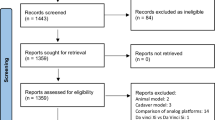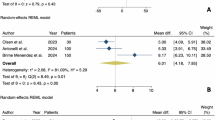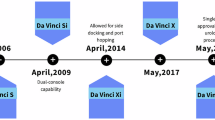Abstract
Background
There is no report upon the remote surgery of radical prostatectomy and comparisons between local surgeries. This study aims to evaluate the feasibility and safety of the innovative remote tele-surgical robotic platforms in performing radical prostatectomy.
Methods
The study comprised 13 patients diagnosed with prostate cancer who underwent remote radical prostatectomy using a 5 G wireless network and the innovative remote robotic systems (Tele-RARP). Additionally, the research involved 31 patients who underwent radical prostatectomy with the local Toumai robotic system (TM-RARP) between October 2022 and April 2024, and 36 patients who underwent radical prostatectomy with the da Vinci Xi platform (Xi-RARP) during the same period under the supervision of the same surgical team. Data on demographics, perioperative factors, clinicopathologic information, and postoperative results were collected for a total of 80 patients.
Results
The completion of 13 Tele-RARP procedures was successful without significant intraoperative or postoperative issues. No instances of intraoperative blood transfusion or surgical conversion were reported. The operation, console, and docking time for both the remote and local surgeries showed minimal differences. Neither local nor remote surgery nor da Vinci Xi surgery exhibited significant variations in terms of blood loss, intraoperative complications, or postoperative prognosis. Both TM-RARP and Tele-RARP presented very manageable task loads.
Conclusions
Performing tele-surgical robotic-assisted radical prostatectomy using the innovative Toumai and Edge robotic surgical systems via a 5 G wireless network is not only feasible but also safe.
Registration number
ChiCTR2400085386, ChiCTR2300077721
This is a preview of subscription content, access via your institution
Access options
Subscribe to this journal
Receive 4 print issues and online access
$259.00 per year
only $64.75 per issue
Buy this article
- Purchase on SpringerLink
- Instant access to full article PDF
Prices may be subject to local taxes which are calculated during checkout



Similar content being viewed by others
Data availability
The data sets generated and/or analyzed during the current study are available from the corresponding author on reasonable request. All the people shown in the photographs published here consented to the taking and use of these images.
References
Cowley G. Introducing “Robodoc”. A robot finds his calling-in the operating room. Newsweek. 1992;120:86.
Marescaux J, Rubino F. The ZEUS robotic system: experimental and clinical applications. Surg Clin North Am. 2003;83:1305–15.
Raison N, Khan MS, Challacombe B. Telemedicine in surgery: what are the opportunities and hurdles to realising the potential?. Curr Urol Rep. 2015;16:43.
Hung AJ, Chen J, Shah A, Gill IS. Telementoring and telesurgery for minimally invasive procedures. J Urol. 2018;199:355–69.
Nguan C, Miller B, Patel R, Luke PP, Schlachta CM. Pre-clinical remote telesurgery trial of a da Vinci telesurgery prototype. Int. J Med Robot + Comput Assist Surg. 2008;4:304–9.
Sterbis JR, Hanly EJ, Herman BC, Marohn MR, Broderick TJ, Shih SP, et al. Transcontinental telesurgical nephrectomy using the da Vinci robot in a porcine model. Urology. 2008;71:971–3.
Marescaux J, Leroy J, Gagner M, Rubino F, Mutter D, Vix M, et al. Transatlantic robot-assisted telesurgery. Nature. 2001;413:379–80.
Tian W, Fan M, Zeng C, Liu Y, He D, Zhang Q. Telerobotic spinal surgery based on 5G network: the first 12 cases. Neurospine. 2020;17:114–20.
Acemoglu A, Peretti G, Trimarchi M, Hysenbelli J, Krieglstein J, Geraldes A, et al. Operating from a distance: robotic vocal cord 5G telesurgery on a cadaver. Ann Intern Med. 2020;173:940–1.
Barba P, Stramiello J, Funk EK, Richter F, Yip MC, Orosco RK. Remote telesurgery in humans: a systematic review. Surg Endosc. 2022;36:2771–7.
Zheng J, Wang Y, Zhang J, Guo W, Yang X, Luo L, et al. 5G ultra-remote robot-assisted laparoscopic surgery in China. Surg Endosc. 2020;34:5172–80.
Li J, Yang X, Chu G, Feng W, Ding X, Yin X, et al. Application of improved robot-assisted laparoscopic telesurgery with 5G technology in urology. Eur Urol. 2023;83:41–44.
Fan S, Zhang Z, Wang J, Xiong S, Dai X, Chen X, et al. Robot-assisted radical prostatectomy using the KangDuo surgical robot-01 system: a prospective, single-center, single-arm clinical study. J Urol. 2022;208:119–27.
Fan S, Hao H, Chen S, Wang J, Dai X, Zhang M, et al. Robot-assisted laparoscopic radical prostatectomy using the KangDuo surgical robot system vs the da Vinci Si robotic system. J Endourol. 2023;37:568–74.
Li Z, Li X, Fan S, Yang K, Meng C, Xiong S, et al. Robot-assisted modified bilateral dismembered V-shaped flap pyeloplasty for ureteropelvic junction obstruction in horseshoe kidney using KangDuo-Surgical-Robot-01 system. Int Braz J Urol J Braz Soc Urol. 2023;49:388–90.
Jing T, Peng D, Yao X, Ye S, Zhao Q, Ni M, et al. Single-port robot-assisted radical prostatectomy with the novel Shurui single-port robotic surgical system. J Endourol. 2023;37:1105–12.
Peng D, Jing T, Yao X, Ye S, Xu X, He A, et al. Preliminary experience of partial nephrectomy through a new single-port surgical robot system. J Endourol. 2023;37:535–41.
Wang Y, Ai Q, Zhao W, Gao Y, Liu Q, Shi T, et al. Safety and reliability of a robot-assisted laparoscopic telesurgery system: expanding indications in urological surgery. Eur Urol. 2023.
Sunyi Y, Yi Z, Anbang H, Ding P, Ping W, Dan X, et al. Inferior vena cava hemangioma resected using a novel Toumai robotic surgical platform. J Vasc Surg Cases Innov Tech. 2024;10:101403.
Huang J, Zhu H, Lu P, Li J, Tian Y, Takase Y, et al. Comparison of lobectomy performed through Toumai(®) surgical robot and da Vinci surgical robot in early-stage non-small cell lung cancer: a retrospective study of early perioperative results. Transl Lung Cancer Res. 2023;12:2219–28.
Bell SW, Kong JCH, Clark DA, Carne P, Skinner S, Pillinger S, et al. The National Aeronautics and Space Administration-task load index: NASA-TLX: evaluation of its use in surgery. ANZ J Surg. 2022;92:3022–28.
Mohamed R, Raman M, Anderson J, McLaughlin K, Rostom A, Coderre S. Validation of the National Aeronautics and Space Administration Task Load Index as a tool to evaluate the learning curve for endoscopy training. Can J Gastroenterol Hepatol. 2014;28:155–9.
Rashid R, Sohrabi C, Kerwan A, Franchi T, Mathew G, Nicola M, et al. The STROCSS 2024 guideline: strengthening the reporting of cohort, cross-sectional, and case-control studies in surgery. Int J Surg. 2024;110:3151–65.
Norasi H, Tetteh E, Law KE, Ponnala S, Hallbeck MS, Tollefson M. Intraoperative workload during robotic radical prostatectomy: Comparison between multi-port da Vinci Xi and single port da Vinci SP robots. Appl Erg. 2022;104:103826.
Dai X, Fan S, Hao H, Yang K, Shen C, Xiong G, et al. Comparison of KD-SR-01 robotic partial nephrectomy and 3D-laparoscopic partial nephrectomy from an operative and ergonomic perspective: a prospective randomized controlled study in porcine models. Int J Med Robot + Comput Assist Surg. 2021;17:e2187.
Xu S, Perez M, Yang K, Perrenot C, Felblinger J, Hubert J. Determination of the latency effects on surgical performance and the acceptable latency levels in telesurgery using the dV-Trainer(®) simulator. Surg Endosc. 2014;28:2569–76.
Bauer J, Lee BR, Stoianovici D, Bishoff JT, Micali S, Micali F, et al. Remote percutaneous renal access using a new automated telesurgical robotic system. Telemed J e-Health J Am Telemed Assoc. 2001;7:341–6.
Marescaux J, Leroy J, Rubino F, Smith M, Vix M, Simone M, et al. Transcontinental robot-assisted remote telesurgery: feasibility and potential applications. Ann Surg. 2002;235:487–92.
Anvari M, McKinley C, Stein H. Establishment of the world’s first telerobotic remote surgical service: for provision of advanced laparoscopic surgery in a rural community. Ann Surg. 2005;241:460–4.
Anvari M. Remote telepresence surgery: the Canadian experience. Surg Endosc. 2007;21:537–41.
Tian Z, Lu W, Wang T, Ma B, Zhao Q, Zhang G. Application of a robotic telemanipulation system in stereotactic surgery. Stereotact Funct Neurosurg. 2008;86:54–61.
Patel TM, Shah SC, Pancholy SB. Long distance tele-robotic-assisted percutaneous coronary intervention: a report of first-in-human experience. EClinicalMedicine. 2019;14:53–58.
Zhang X, Ciais P, Jian X, Liu X, Wang R, Chen K, et al. The carbon footprint response to projected base stations of China’s 5G mobile network. Sci Total Environ. 2023;870:161906.
Funding
This work was supported by the National Natural Science Foundation of China (82303143 to DP), Zhejiang Provincial Natural Science Foundation (LQ23H160027 to DP), and Science and Technology Department of Zhejiang Province (2024C03198).
Author information
Authors and Affiliations
Contributions
Conception and design: DX, SW, and ZYH. Data acquisition: SYY, DP, LXZ, YZ, YLY, JSC, and JZ. Data analysis and interpretation: LXZ, ABH, TLJ, XLY, SLW, QQZ, JYC, and PW. Drafting of the manuscript: SYY, DP, YZ, ABH, TLJ, XLY, SLW, QQZ, and JYC. Critical revision of the manuscript for important intellectual content: YLY, JSC, JZ, PW, DX, SW, and ZYH. Statistical analysis: SYY, DP, YZ, YLY, JSC, JZ, ABH, TLJ, XLY, SLW, QQZ, and JYC. Obtaining funding: DP. Administrative, technical, or material support: SYY, DX, SW, and ZYH. Supervision: PW, DX, SW, and ZYH. Other: None.
Corresponding authors
Ethics declarations
Competing interests
The authors declare no competing interests.
Ethical approval
This prospective clinical study was approved by the Ethics Committee of The First Affiliated Hospital School of Medicine Zhejiang University. All patients provided written informed consent, which included disclosure of surgical risks and explicit permission for the use of intraoperative images (including Fig. 3) in scientific publications. All methods adhered to the relevant guidelines and regulations, including the Declaration of Helsinki and its later amendments or comparable ethical standards.
Additional information
Publisher’s note Springer Nature remains neutral with regard to jurisdictional claims in published maps and institutional affiliations.
Supplementary information
Rights and permissions
Springer Nature or its licensor (e.g. a society or other partner) holds exclusive rights to this article under a publishing agreement with the author(s) or other rightsholder(s); author self-archiving of the accepted manuscript version of this article is solely governed by the terms of such publishing agreement and applicable law.
About this article
Cite this article
Ye, S., Peng, D., Zhu, L. et al. 5G-remote radical prostatectomy under novel robotic systems: a prospective comparative cohort study with local surgeries. Prostate Cancer Prostatic Dis (2025). https://doi.org/10.1038/s41391-025-01004-4
Received:
Revised:
Accepted:
Published:
DOI: https://doi.org/10.1038/s41391-025-01004-4



